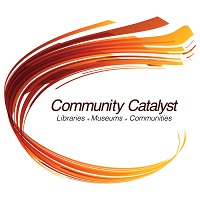Blog Posts | January 26, 2017
Share This
Editor’s Note: This past fall, IMLS launched Community Catalyst, a new initiative aimed at sparking a conversation around ways to help libraries and museums develop a deeper understanding of the best ways to work with communities to bring about positive change. Through a cooperative agreement with Reinvestment Fund, the agency scanned the literature and gathered input from the library, museum, and community revitalization fields. The results of that scan are part of a newly released report (PDF, 28MB). This is the latest in a series of blogs this month highlighting the initiative.
By Dr. Kathryn K. Matthew
Director
Growing up as I did in South Carolina, New Year’s Day was always celebrated with collard greens, biscuits, a field pea and rice pilau, and gumbo. While the menu was the same all across the Lowcountry, what the cook carried out of the kitchen was not. Were the biscuits sweet or salty? Did the gumbo have chicken, shrimp, fish, or just veggies…and how much okra was in there? Was there cooking going on all day or just a short while? I’ve heard it said in the South that we only have two kinds of fancy cooking: biscuit baking and soup stewing. There’s a lesson there. Each of those types of cooking favor a different type of cook.
Biscuits require precise measurements, carefully followed instructions (remember that the baking powder goes in first before the liquid ingredients) the right kind of flour (soft winter wheat), and if a storm’s coming remembering to turn down the oven by 10 degrees so the biscuits don’t dry out before they brown.
Making a good gumbo is hard to do too, but for different reasons. Gumbo requires a willingness to improvise, to adapt to what’s available, and to adjust the seasoning to taste. No two batches are quite the same because no two tastes are quite the same.
Community work is more like gumbo than biscuits. Everyone knows that your collaborators will be the “catch of the day,” but, are the right ingredients available, picked at their prime, or are you working from out-of-season stock? Will the flavors blend to create that memorable smoothness of good gumbo or will one flavor, a sharp onion, say, dominate the stew? Maybe it’s a bad year for shrimp. The “hard to do” part of community work is knowing when the time, place, and people are right. It’s not New Year’s Day all year long, after all.
Organizational Readiness is perhaps the most discussed, most misunderstood, and most critical part of creating community change. Many examples abound of articles, seminars, courses, and books cover this topic. By now you can probably see why. At our September 2016 Community Catalyst Town Hall one participant said:
“[Those who]…were most successful [at community change] see this as a continuous, iterative infusion of community development skills and experience.”
This is gumbo-making. It is not biscuits. I particularly like the “iterative” part. How long does it take to make a good gumbo? Probably about twenty years, perhaps less if you have someone working alongside you for some of those years. Learning from each other is why we hold these Town Halls.
The authors of the Community Catalyst report write:
“There is great variety in the museums-and-libraries field that affects how and why any individual institution serves its community and the resources it brings to the table.”
That is the “hard to do” part about making good gumbo too, what you start with is not necessarily the same in each household.
So when attempting to engage with your community there is no fixed recipe. Rather you need to be an adaptable cook who successfully blends what’s available. Not only do you need to pay attention to the dynamics outside your organization, you need to look at your internal readiness as well. Are you mainly publicly or mainly privately funded? Which of your programs are expected to generate revenues to cover the costs of the rest? How much is your audience/patron base changing? How will the necessity of maintaining a revenue stream balance with your attempts, perhaps untested, to create community change? Each of these flavors the mix. Fortunately, many of the factors that indicate community readiness can be applied to thinking about organizational readiness.
One participant in our Town Hall wrote:
“As a museum director, it would have been helpful to know how other professionals in the field feel about the changing dynamic changes in donor/patronage landscape. How are we impacted by the new generation of donors, who have become less [broadly] philanthropic and more interested in a [crowd-sourced fundraising] approach.”
Put in gumbo terms, this is a sniff of a strong onion. Can your museum or library blend the different pressures and expectations? This particular Museum Director is asking for us to share what the field has learned to deepen our collective pool of experience. Note that the question is NOT “exactly how much of this onion do I put in?” That is for the biscuit-makers. The question is how to blend the flavors.
Here’s another comment from a “season to taste cook” in the making:
“This [Town Hall] session helped me to understand and reconcile the false opposition many on our board and in the community perceive between social services and culture work.”
A staff’s interactions with their board, with influential donors, and with hard-working volunteers takes artful blending and balance. Now mix in the input and engagement of the many additional stakeholders from your community. Remember you’ve got to season to taste. The mix can be subtly flavored by meeting locations, language used, project roles, sharing of information, and even definition of community metrics to be tracked. It can also be influenced by the selection of staff hired for community work, their level of seniority, and their influence within our organization. You can sample the stew by listening closely to shared stories that emerge.
This kind of cooking is hard, but you might be surprised at how people rise to the challenge. It may even stimulate a greater commitment to staff training.
“This [discussion] brought customer service to the fore in a way that was extremely helpful to me. It helped me isolate issues and I knew just how I was going to explain this when I got back...“
So in other words, while a simple okra pod can start a gumbo, it alone can’t make it good. You need to create a smoothness, a blend of flavors, to tie the dish together. It takes a willingness to experiment, to draw on experience (yours and that of others), to get it just right.
One participant summed it up….
“The Town Hall, and nearly all in attendance, are challenging those low expectations for librarians/libraries and museums, and challenging us to develop our vision of ourselves and institutions. It also began to build a community of more ambitious, entrepreneurial, deep thinking, and strongly principled collaborators determined to use our talents and resources to address the critical issues of our day.”
Note that the resource hyperlinks are intended to be illustrative only, are not prescriptive, and do not imply endorsement of any particular resource or approach

About the Author
Dr. Kathryn K. Matthew was confirmed by the Senate in September 2015 as the 5th director of the Institute of Museum and Library Services. You can send her comments on the Community Catalyst Initiative by emailing communities@imls.gov
